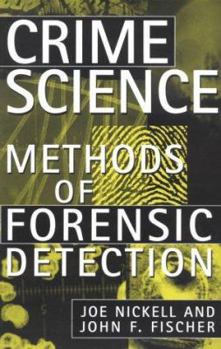Crime Science: Methods of Forensic Detection
Select Format
Select Condition 
Book Overview
" The O.J. Simpson trial. The Lindbergh kidnapping. The death of Marilyn Monroe. The assassination of the Romanovs. The Atlanta child murders. All controversial cases. All investigated with the latest techniques in forensic science. Nationally respected investigators Joe Nickell and John Fischer explain the science behind the criminal investigations that have captured the nation's attention. Crime Science is the only comprehensive guide to forensics...
Format:Hardcover
Language:English
ISBN:0813120918
ISBN13:9780813120911
Release Date:December 1998
Publisher:University Press of Kentucky
Length:310 Pages
Weight:1.30 lbs.
Dimensions:1.1" x 6.2" x 9.3"
Grade Range:Postsecondary and higher
Customer Reviews
5 ratings
Got it for a class
Published by Thriftbooks.com User , 17 years ago
Needed and this place usually has the books that I need. Even better it comes quickly and most products are in great condition. Was a good read and will be a keeper for understanding crime scene analysis.
Case Studies of Famous Crimes
Published by Thriftbooks.com User , 20 years ago
This book will provide an education to the general reader. Forensic science is "the study and practice of the application of science to the purposes of the law". Page 4 gives Newcomb's Rule, but provides no proof of verification. Eyewitness evidence is subjective and colored by attitudes and perceptions. If a witness is mistaken or lying, there is no way to tell. Physical evidence is objective, but may have subjective aspects. [The authors ignore the topic of planted evidence. They don't tell that expert witnesses support the side that pays them.] Forensic science dates from the early 19th century with modern chemistry and toxicology. Mistaken identification can occur from photographs as well as live persons (p.7). The paragraph on firearms examination omits the pioneering work done in Germany and first used by Earl Rogers in California (p.10). The paragraph on questioned document examination ignores work done in Europe centuries earlier (p.11). Page 14 tells that government forensic laboratories are usually unavailable to the defense. The book "Tainted Evidence" explains why this is a problem due to the lack of objectivity. Chapter 2 explains the techniques of "Crime Scene Investigation". Fingerprints should be photographed before lifting (p.28). This prevents planting evidence, as in the Trial of Alfred de Marigny. The Case Study is the Jeffrey Macdonald case. I read that Cyril Wecht M.D., J.D. said some of his wounds could not be self-inflicted; the book "Fatal Justice" gives more details. This may not be the best example for a textbook case. Chapter 4 says placing firearms "in the hands of the peasant class" resulted in murders! Like with Robin Hood? The case study is the Sacco-Vanzetti trial (a controversial case - see page 103). Dr. Henry C. Lee's "Famous Crimes Revisited" says "the custody of all the bullets had never been traced". This case study proves Sacco & Vanzetti innocent IMO. One robber shot Berardelli, then chased Parmenter and shot him twice. The other robber shot Berardelli three times. But only one of the bullets submitted in evidence came from Sacco's gun! This suggests evidence planted to convict Sacco & Vanzetti. A third robber jumped into the getaway car that had two other men. This sounds like professionals who had a plan and left no witnesses. Were Sacco & Vanzetti posthumously rehabilitated by the State of Massachusetts? Chapter 7 covers questioned document examination. Suppose a suspect is asked to copy a ransom note 'to prove his innocence'. If somehow this becomes the state's evidence, would that prove innocence? Chapter 8 tells about blood, the substance most commonly found at the crime scene, or on a person, clothing, or weapon. Tests to identify blood have been known since 1875 using various chemicals, to today's use of DNA. The case study is the O. J. Simpson trial, the most publicized case since Dr. Sam Sheppard. The authors admit "it would have been possible later to switch the collected evidence for fa
good
Published by Thriftbooks.com User , 22 years ago
Compare to some other books on case studies, this book has less cases than others. However, it gives more details and explains by different forensic methods. It helped me a lot with my forensic-case-study paper.
A good overview
Published by Thriftbooks.com User , 24 years ago
This book gives a broad overview of the various aspect of forensic science. There is not a lot of depth on some topics but there are a lot of references for further reading.
Good book for police or anyone interested in forensics.
Published by Thriftbooks.com User , 25 years ago
Good reading cover to cover. A little dry through the fingerprint section. Good case studies illustrate chapters key points. I think this books greatest strength is that all information is referenced at the end of the book if further study is required. Also "recommended reading" is provided at the end of each chapter to allow the reader to explore interests if desired. Information is one step up from what might be provided in police academy coursework.






